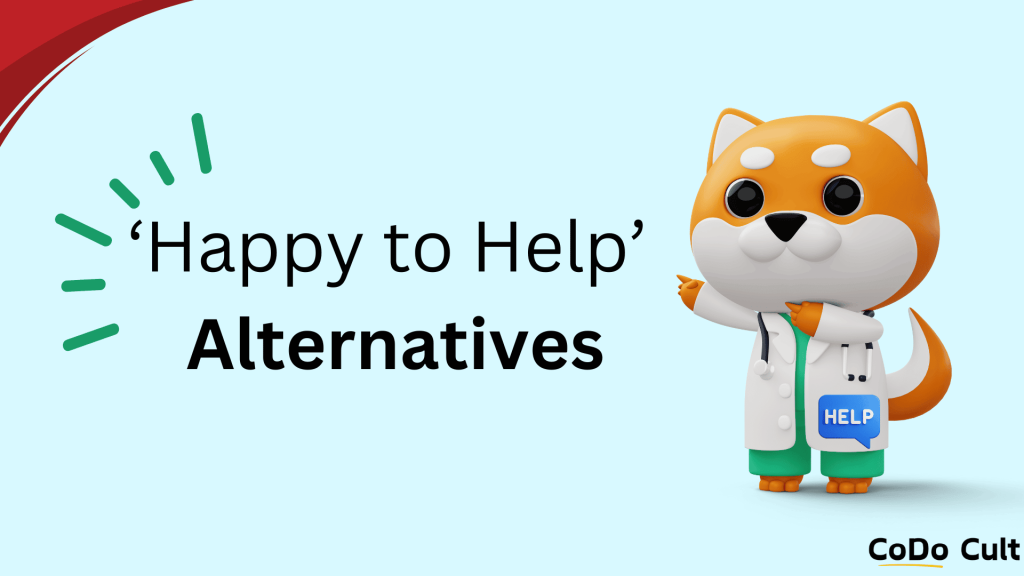To be honest, there is nothing wrong with saying “Happy to help”. I worked in a company as a support Engineer where I always used this phrase. Day by day I felt myself using this more often. So, I decided to bring a change so that there would be more energy and eagerness in my words that I am going to use. This would certainly improve the business and bring more satisfaction from the customer’s side.

Customer service representatives can choose different phrases in their daily interactions with customers to convey a more authentic desire to assist.
These alternative phrases to “happy to help” can improve your support team’s communication skills and enhance the overall customer service experience.
This blog presents a collection of phrases to replace the commonly used “happy to help,” offering variety to your communication toolkit.
Table of Contents
Glad to assist.
This phrase conveys a sense of happiness and willingness to help. It suggests that the person is eager and pleased to help.
Example:
A user contacts IT support with a software issue. The technician responds, “I’m glad to assist you with resolving the problem you’re experiencing.”
Delighted to help.
This phrase conveys genuine happiness in helping. It suggests that the person finds fulfilment in aiding others.
Example:
A user expresses gratitude to the IT support team for resolving an issue promptly. The technician responds, “I’m delighted to help out. It’s what we’re here for!”
Here for you
This expression conveys a sense of support and availability. It assures the person that assistance is readily accessible whenever needed.
Example:
A staff member encounters difficulty accessing a shared drive. The IT support representative reassures them, saying, “Don’t worry, I’m here for you. Let’s troubleshoot the issue together.”
Ready to support.
This phrase communicates preparedness and willingness to aid. It assures the person that help is available and accessible.
Example:
A user encounters a network connectivity issue. The IT support specialist says, “I’m ready to support you in resolving the connectivity issue. Let’s troubleshoot together.”
Happy to lend a hand.
This expression conveys a positive and helpful attitude. It suggests that the person is pleased to offer assistance and support.
Example:
A colleague asks for help in configuring a new software application. Another team member responds, “I’m happy to lend a hand. Let’s tackle this together.”
At your service.
This phrase emphasizes readiness and willingness to assist. It conveys a sense of dedication and availability to fulfil the needs of others.
Example:
A user expresses appreciation for the prompt response from IT support. The technician replies, “Thank you! We’re always at your service, ready to assist with any IT-related issues you may encounter.”
Here to make things easier.
This expression communicates a commitment to simplifying processes and resolving difficulties. It assures the person that assistance is aimed at improving their experience.
Example:
A customer struggles with navigating a new software interface. The IT support representative says, “Don’t worry, I’m here to make things easier for you. Let’s go through the steps together to ensure a smoother experience.”
Content to be of assistance.
This phrase conveys a sense of satisfaction in providing help. It suggests that the person is pleased to be able to offer support.
Example:
A user expresses gratitude for the guidance provided by IT support. The technician responds, “I’m content to be of assistance. Don’t hesitate to reach out if you have any further questions.”
More than willing to aid.
This expression communicates eagerness and readiness to help. It assures the person that help is readily available and offered willingly.
Example:
A colleague encounters difficulty accessing a shared document. Another team member helps, saying, “I’m more than willing to aid. Let me know how I can help resolve the issue.”
Cheerful to help you out.
This phrase conveys a positive and supportive attitude. It suggests that the person is happy and enthusiastic about helping.
Example:
A user expresses frustration with a software glitch. The IT support representative responds, “Don’t worry, I’m cheerful to help you out. Let’s work together to find a solution.”
Pleased to be of service.
This expression conveys satisfaction and happiness in helping. It suggests that the person finds fulfilment in being able to help others.
Example:
A customer expresses appreciation for the prompt resolution of a technical issue. The IT support agent replies, “I’m pleased to be of service. If you have any further questions, don’t hesitate to ask.”
You can rely on me for help.
This phrase communicates trustworthiness and dependability. It assures the person that assistance is available and can be counted on.
Example:
A team member encounters difficulty accessing a shared file. Another colleague reassures them, saying, “Don’t worry, you can rely on me for help. Let’s troubleshoot the issue together.”
Feel free to reach out anytime.
This expression encourages open communication and assures the person that assistance is available whenever needed.
Example:
A user encounters an error message while using a software application. The IT support representative says, “If you encounter any issues in the future, feel free to reach out anytime. We’re here to help.”
I’m at your beck and call.
This phrase conveys readiness and availability to provide immediate assistance. It assures the person that help is just a request away.
Example:
A colleague encounters difficulty connecting to a virtual meeting. Another team member helps, saying, “Don’t worry, I’m at your beck and call. Let me know how I can assist you.”
Here to make things easier for you
This expression communicates a commitment to simplifying processes and resolving difficulties. It assures the person that assistance is aimed at improving their experience.
Example:
A customer struggles with navigating a new software interface. The IT support representative says, “Don’t worry, I’m here to make things easier for you. Let’s go through the steps together to ensure a smoother experience.”
Employ the finest substitutes for the expression ‘happy to help’
In customer service, authenticity in your responses, beyond mere phrases like ‘happy to help,’ builds trust and fosters genuine connections. Even when issues require escalation, sincere efforts resonate with customers, defining excellence in service interactions.



